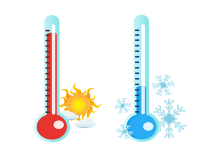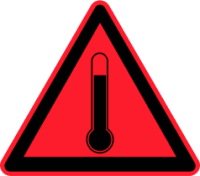 Many times, we are asked about the effects of thermal cycling on rare earth permanent magnets, but there is not a simple rule of thumb to offer. From a first order standpoint, thermal cycling will degrade the performance of rare earth Neodymium Iron Boron and Samarium Cobalt magnets. There are two primary mechanisms which drive this degradation. One occurs quickly, and the second occurs over a long period of time.
Many times, we are asked about the effects of thermal cycling on rare earth permanent magnets, but there is not a simple rule of thumb to offer. From a first order standpoint, thermal cycling will degrade the performance of rare earth Neodymium Iron Boron and Samarium Cobalt magnets. There are two primary mechanisms which drive this degradation. One occurs quickly, and the second occurs over a long period of time.
The demagnetization effect which manifests first is a result of some of the magnetic domains in the alloy reorienting and no longer contributing to the overall net magnetic field of the magnet. (The magnetic domains which reorient first are considered “weak”, as they are the most susceptible to external affects.) This loss will always occur in magnets, as there are always “weak magnetic domains”, but the loss can be exacerbated by thermal cycling and usually occurs within the first few thermal cycles.
The fact that the initial magnet degradation occurs in the first few thermal cycles can be an advantage, as the magnets can be easily thermally cycled, or “soaked”, prior to integration into the next assembly. This pre-cycling removes the variability between magnets and pre-degrades the magnets to a level that they would eventually achieve in operation.
The second demagnetizing effect is more metallurgical and goes to grain boundary oxidation and thermal creep. Essentially, the transition regions between some of the domains start to breakdown. The weaker domains, now no longer fully constrained, partially reorient and contribute less to the net field generated by the magnet. This type of degradation will always occur, but the degree of the effect can be exacerbated by thermal cycling. This effect usually takes many years for well-made, fully saturated magnets. (In general, Neodymium Iron Boron magnets are more susceptible to corrosion, and this loss is more prevalent compared to Samarium Cobalt magnets.)
Both of these effects are usually minor, and the field loss can range from 100ths of a percent to several percent. The degree of loss is mostly controlled by starting with a quality magnet.
The effects are difficult to anticipate and quantify because experimental data is lacking. These magnetic losses do not lend themselves to accelerated testing. There has been a recent [1]IEEE paper on this subject, but it fails to offer a functional correlation between the experimental data and an actual rare earth magnet’s net degradation over a lifetime. With that said, it does show that most losses occur within the initial thermal cycles, and this is generally accepted within the magnet industry. This loss was described above, and it results from weaker domains reorienting. Longer term effects from thermal cycling are less conclusive, and therefore no concrete conclusion regarding long term effects can be derived from the study.
A potential ancillary correlation can be drawn from the paper, but more from an anecdotal observation. The higher the Intrinsic Coercive Force (Hci), the better the overall resistance the magnet has to demagnetizing from thermal cycling. While this may be true, it has been proven, and can be operationally observed, that the higher the Hci of the magnet, the better the resistance to demagnetization of the magnet to most all demagnetizing effects (external magnetic demagnetizing fields, high heat, poor magnetic geometries, etc.). So, this was not unique and would be expected.
 One aspect not yet discussed is that the thermal cycling must always reside in the temperature extremes tolerated by the magnet. Meaning that, regardless of the number of thermal cycles, the temperature cycle range must not exceed the magnet’s heat tolerance capability. If a magnet is exposed to heat higher than its upper threshold, then a different demagnetizing loss is experienced, and it is no longer an exclusive loss from thermal cycling.
One aspect not yet discussed is that the thermal cycling must always reside in the temperature extremes tolerated by the magnet. Meaning that, regardless of the number of thermal cycles, the temperature cycle range must not exceed the magnet’s heat tolerance capability. If a magnet is exposed to heat higher than its upper threshold, then a different demagnetizing loss is experienced, and it is no longer an exclusive loss from thermal cycling.
Takeaways and items for consideration:
- There is not a general rule of thumb for estimating the magnetic loss in a magnet from thermal cycling.
- Most of the loss will occur within the first few thermal cycles.
- Magnets which will experience thermal cycling in the application can be pre-soaked (thermally exposed) prior to integration into the next assembly. This process allows for normalization to a state that the magnets would eventually achieve, but during operation.
- Grain boundary oxidation “magnetic creep” is a very long term effect and is very difficult to estimate.
- In general, higher quality magnets suffer thermal demagnetizing affects less than lower quality magnets.
Higher quality magnets:
- are made with more consistent particle sizes
- have less contaminates in their matrix
- have better control of heat distribution during the sintering process
- have better magnetic orientation during the pressing
- use more Dysprosium as a crystal dopant to achieve higher coercivity
- In general, magnets with higher Intrinsic Coercive Force (Hci) will resist all magnetizing effects better than magnets with having a lower Hci.
Conclusion:
Thermal cycling will degrade a magnet’s magnetic output, but it is difficult to anticipate the degree of degradation. There are two main mechanisms that contribute to thermal degradation. One occurs quickly: reorientation of weak domains. The second occurs over a longer time period: grain boundary oxidation. The higher the quality of the magnet, the greater likelihood the magnet will resist degradation from thermal cycling. Please contact a Dura Magnetics Application Specialist for help in integrating magnets in your thermal cycling application.
—
[1] Huger, Daniel and Gerling, Dieter, The Effects of Thermal Cycling on Aging of Neodymium –Iron –Boron Magnets, IEEE 978-1-4799-4402, pp 389-392, 9-12 June 2015

